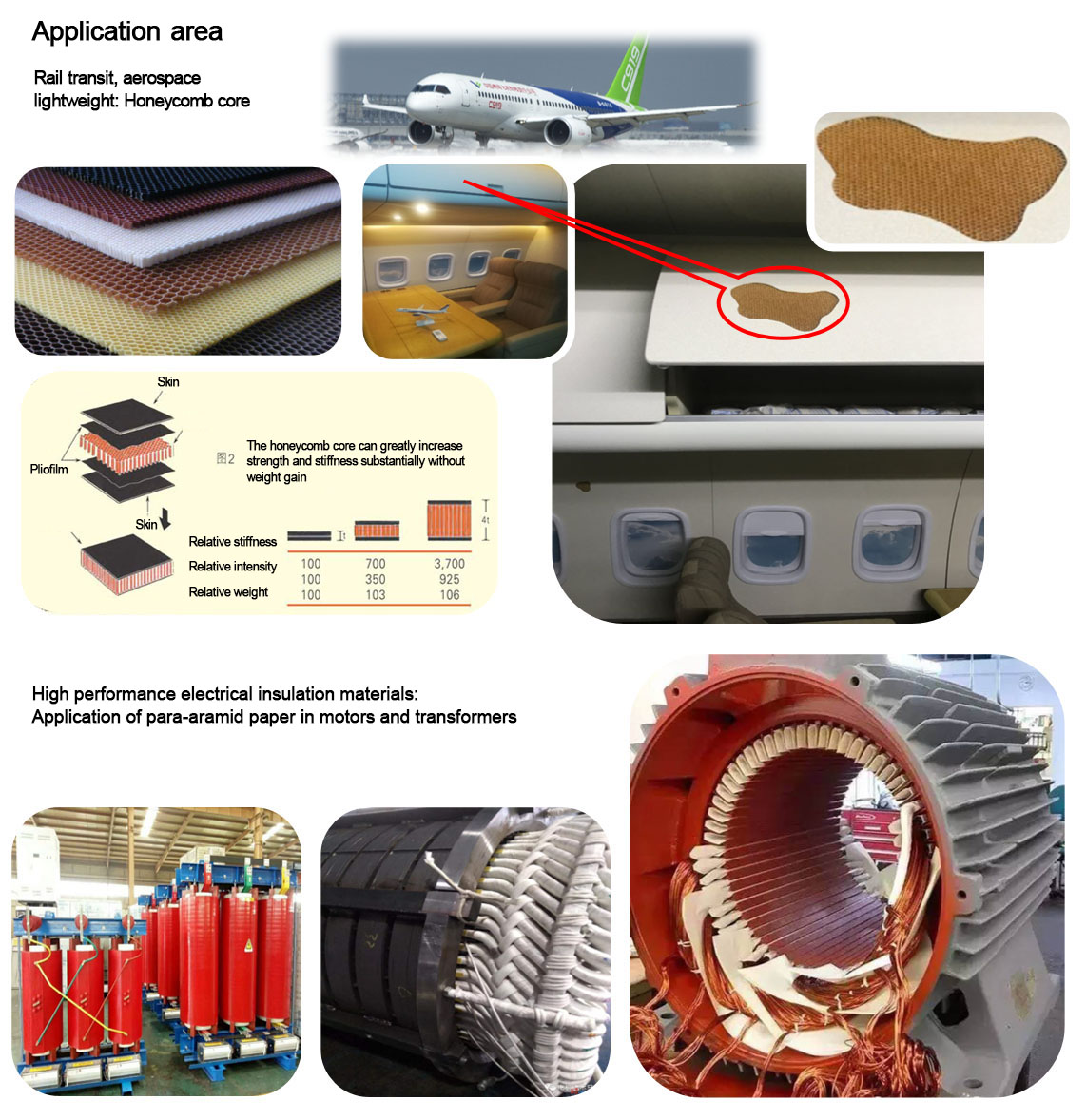COPYRIGHT © 2019 Shandong Jufang New Material Co., Ltd.
Para aramid paper
Since the specific strength and specific modulus of para-aramid are 6 times and 3 times that of steel wire, and 2 times and 10 times that of high strength nylon, they can maintain normal levels in the temperature range of -200 ℃-200℃. Under the premise of the same tensile strength, the para-aramid skeleton material can greatly reduce the quality of rubber products and can be used in extreme weather conditions. The para-aramid has excellent low creep, fatigue resistance, low heat shrinkage and chemical corrosion resistance, which can significantly improve the dimensional stability and service life of rubber products.
Table 2 Comparison of Properties of Commonly Used Fiber Reinforced Materials:
|
Item
|
Para-aramid
|
Steel wire
|
Rayon
|
Nylon 66
|
Polyester industrial yarn
|
|
Density/g cm'³ |
1.44 |
7.85 |
1.53 |
1.14 |
1.38 |
|
Decomposition temperature(N₂)/℃ |
>500 |
1600 |
200 |
255 |
260 |
|
Tensile strength/MPa |
2830 |
2550
|
780
|
960
|
1150
|
|
Specific strength |
|
|
|
|
|
|
mNtex'¹ |
1970
|
300 |
510 |
840 |
830 |
|
g·d |
22.3 |
3.7 |
5.8 |
9.5 |
9.4 |
|
Initial modulus/GPa |
80 |
160
|
18
|
6
|
14
|
|
Specific modulus |
|
|
|
|
|
|
Ntex-¹ |
55
|
20 |
12
|
50
|
10
|
|
g·di-¹ |
600 |
220 |
140
|
60
|
110
|
|
Thermal expansion coefficient/10-.6°F |
-2.2 |
3.7 |
-
|
-
|
-
|
|
Elongation at break% |
3.6 |
1.9 |
13
|
20
|
13.5
|
|
Heat resistance(200°Cx48h)/% |
90 |
100 |
20
|
45
|
55
|
|
Air dry heat shrinkage(160°C×4mins)%
|
<0.1
|
0
|
1.0
|
3.8
|
5.0
|
[Ma Qianli, Liu Zhen, Lin Weihong, Huang Xiaoting “Development Status of Para-aramid Reinforced Rubber Composites Industry” www.iooroo.cpm]
Para-aramid is widely used in the reinforcement and protection of rubber products such as tires, conveyor belts, driving belts and hoses. Aramid filaments (original filaments) are usually not directly used for rubber reinforcement. They are twisted to improve the mechanical properties such as breaking strength and elongation of the fibers, and soaked in glue to improve the interfacial bonding properties between the fibers and the rubber. The aramid twisted yarn can be directly used for belt reinforcement after being soaked in glue. If used for the reinforcement of tires, conveyor belts or hoses, it also needs to be processed into cord fabric, canvas or mesh.
In addition, if para-aramid is processed into diffuse gum staple fiber or masterbatch and uniformly dispersed in the rubber matrix, it can reduce the endogenous heat of the rubber product, improve the wear resistance, and further prolong the service life.
Table 3 Commercialized para-aramid reinforced tire applications:
| Tire dealer | Aramid mark | Tire brand |
Enhanced parts |
Auto brands |
|
Goodyear |
Kevlar |
Fortera、 Wrangler |
Silent Armor |
Jeep |
|
Michelin |
Twaron |
Eagle F1 |
Response Edge |
Porsche, BMW, Ferrari |
|
Dunlop |
KevlarEE |
Pilot Super Sport |
Ceinture/ Belt |
/ |
|
Pirelli |
Twaron Kevlar |
SP Sport MaxxTT |
Sidewall |
Aston Martin Ferrari Maserati |
|
Continental |
Twaron |
P-Zero |
Sidewall Cap Ply |
Audi R8 Porsche 911 Tesla ModelS |
|
Cooper |
Twaron |
- |
Aralon350M Hybrid Cap Ply |
/ |
|
Nokian |
Twaron |
ZLineSUV |
Belt/Bead |
Audi RS6 |
|
Bridgestone |
Kevlar |
Potenza |
Aramid/Nylon Belts |
Aston Martin Rapide FerrariF458 |
Technical standard for JF910A para-polyarylamide:
|
Scale
|
Unit
|
Index value |
||
|
Nominal thickness |
mm |
0.05 |
0.08 |
0.13 |
|
Thickness |
mm |
0.055±0.007 |
0.08±0.01 |
0.13±0.015 |
|
Quantitative |
g/m² |
41±3 |
63±5 |
116±8 |
|
Longitudinal tensile strength |
KN/m |
≥2.7 |
≥3.3 |
≥4.1 |
|
Horizontal tensile properties |
KN/m |
≥2.1 |
≥2.7 |
≥3.3 |
|
Longitudinal elongation |
% |
≥1 |
≥1 |
≥1 |
|
Lateral elongation |
% |
≥1 |
≥1 |
≥1 |
|
Longitudinal tearing resistance |
N |
≥0.6 |
≥1.3 |
≥1.8 |
|
Lateral tearing resistance |
N |
≥1.0 |
≥1.8 |
≥2.4 |
|
Dielectric strength |
kv/mm
|
≥15 |
≥15 |
≥15 |
|
Relative dielectric constant |
/
|
≤1.5 |
≤1.8 |
≤2.1 |
|
Dielectric loss factor |
x10-³ |
≤10 |
≤10 |
≤12 |
|
纵Longitudinal heat shrinkage@300℃,40min |
% |
≤2 |
≤2 |
≤2 |
|
Lateral heat shrinkage@300°C40min
|
%
|
≤2
|
≤2
|
≤2
|
Technical standard for JF912B para-polyarylamide:
|
Scale
|
Unit
|
Index value |
||
|
Nominal thickness |
mm |
0.05 |
0.08 |
0.13 |
|
Thickness |
mm |
0.055±0.008 |
0.08±0.01 |
0.13±0.015 |
|
Quantitative |
g/m² |
41±3 |
63±5 |
116±8 |
|
Longitudinal tensile strength |
KN/m |
≥2.4 |
≥3.0 |
≥3.7 |
|
Horizontal tensile properties |
KN/m |
≥2.0 |
≥2.4 |
≥3.0 |
|
Longitudinal elongation |
% |
≥1 |
≥1 |
≥1 |
|
Lateral elongation |
% |
≥1 |
≥1 |
≥1 |
|
Longitudinal tearing resistance |
N |
≥0.5 |
≥1.1 |
≥1.5 |
|
Lateral tearing resistance |
N |
≥0.8 |
≥1.5 |
≥2.0 |
|
Dielectric strength |
kv/mm
|
≥20 |
≥20 |
≥20 |
|
Relative dielectric constant |
/
|
≤1.5 |
≤1.8 |
≤2.1 |
|
Dielectric loss factor |
x10-³ |
≤10 |
≤10 |
≤12 |
|
纵Longitudinal heat shrinkage@300℃,40min |
% |
≤2 |
≤2 |
≤2 |
|
Lateral heat shrinkage@300°C40min
|
%
|
≤2
|
≤2
|
≤2
|
Technical standard for JF912B para-polyarylamide:
|
Scale
|
Unit
|
Index value |
||
|
Nominal thickness |
mm |
0.13 |
0.18 |
0.25 |
|
Thickness |
mm |
0.13±0.03 |
0.018±0.04 |
0.25±0.05 |
|
Quantitative |
g/m² |
40±3 |
64±5 |
75±6 |
|
Longitudinal tensile strength |
KN/m |
≥2.1 |
≥2.6 |
≥3.0 |
|
Horizontal tensile properties |
KN/m |
≥1.6 |
≥2.0 |
≥2.4 |
|
Longitudinal elongation |
% |
≥1 |
≥1 |
≥1 |
|
Lateral elongation |
% |
≥1 |
≥1 |
≥1 |
|
Longitudinal tearing resistance |
N |
≥0.4 |
≥1.0 |
≥1.2 |
|
Lateral tearing resistance |
N |
≥0.6 |
≥1.4 |
≥1.6 |
|
Dielectric strength |
kv/mm
|
≥12 |
≥12 |
≥12 |
|
Relative dielectric constant |
/
|
≤1.5 |
≤1.8 |
≤2.1 |
|
Dielectric loss factor |
x10-³ |
≤10 |
≤10 |
≤12 |
|
纵Longitudinal heat shrinkage@300℃,40min |
% |
≤2 |
≤2 |
≤2 |
|
Lateral heat shrinkage@300°C40min
|
%
|
≤2
|
≤2
|
≤2
|


